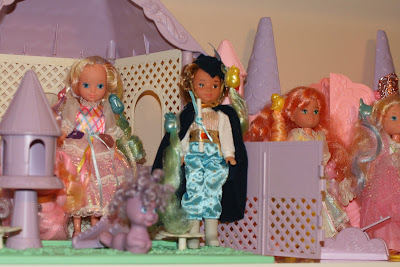Tuesday, October 12, 2010
The Hedonic Tredmill and My Little White Shelf
I have been in bed for the past five days recovering from a minor abdominal surgery. During this time I have had the pleasure of finishing several books on social sciences and psycology. I am always interested in how the human brain works and how it relates to life's troubles (sugery) and joys (toys!) and I always want to maximize my experiences of pleasure while minimizing the things I find lame.
I started collecting very early and even though I loved getting a new toy and shopping for toys I began to notice a problem. When I had all my toys together in one big room stacked to the ceiling I felt rather gross, kind of like the old ladies on Hoarders. I suddenly couldn't focus, didn't appreciate that hard to find item or that completed set. Everything looked like a rainbow of sameness and I got sick of my room-o-toys and put everything in storage for awhile.
That feeling didn't mean I was suddenly done collecting or that I lost interest in toys. On the contrary, I was always looking for more and trying to complete sets and collections. I struggled for years on what I should focus on and how much time and money I should spend on the hobby, and now that I am a bit older I think I have come up with the perfect "toy enjoyment" equation.
The hedonic treadmill is a principal of the human condition that states no matter what joys and sorrows we add to our lives we will eventually bob back to the same depth of happiness or misery we enjoyed before the joy or sorrow was added to the mix. In other words, a new rare UK My Little Pony in the mail might give me a day, a week, a month of happiness, but eventually I will require another rare beauty to come along in order to maintain that happiness. That burst of joy will fade and that pretty pony will become another hunk of plastic in my collection.
The book "The Upside to Irrationality" gave an answer to how we can maintain that new burst of joy for as long as possible. In several studies involving a vacuum cleaner and a DVR (I wont bother repeating them here because I am lazy) behavioral psychologists came to the conclusion that in order to make happy things last longer you must interrupt them. On the flip side, in order to make unpleasant things go as quickly as possible, you must take care of it all at once, without interruption.
How does this apply to toy collecting?
When we moved into our new house, long before I learned about the hedonic treadmill, I decided that I would continue toy collecting under the following conditions:
1) The item had to be cheap or a very very good deal. In order to find those deals I have to wait and wait and wait. (Interruption) I don't get to have everything I want now, I have to wait until it is half the usual cost or dirt cheap at a thrift store.
2) I only have one shelf in which to display my toys. This satisfies the principles of interruption by "hiding" the items I have and only trotting them out on display maybe only a few weeks out of the year. With this tecnique I never get the color-overwhelm or feel "grossed out" by my hoarding. I also do not take the toys for granted.
So, even though I love seeing the big toy rooms online I enjoy a small display here at home. Today I felt good enough to get out Lady Lovely Locks and put her on the little white shelf.
Subscribe to:
Post Comments (Atom)








I like this idea. I don't have all my toys out because there are too many and I hate dusting! I do have quite a few on display but can see how having them all out would be a bit much.
ReplyDelete